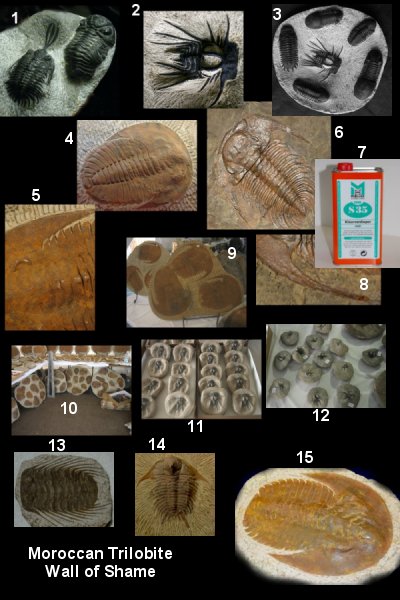Buying
fossils on eBay in the early years
The
images composited in the "wall of shame" graphic below were taken
from among many sent to me by my friends at Fossil Mall, and were
either
taken
from
eBay or during annual trips to the Tucson Fossil Show. While
hardly
exhaustive,
the selection does illustrate some of the commonly seen fakes either
coming out of Morocco, or those receiving further aesthetic enhancements
after being exported. Fossil fakery in Morocco has existed
for
decades
-  and
fakes
are ubiquitously found on the market - that's the bad news. The
good news is that the advent of modern preparation equipment and
skills
in Morocco is resulting in some truly remarkable authentic specimens,
and to some extent rendering fakery less lucrative and widespread,
i.e., it's harder for the fakes to compete with the authentic. and
fakes
are ubiquitously found on the market - that's the bad news. The
good news is that the advent of modern preparation equipment and
skills
in Morocco is resulting in some truly remarkable authentic specimens,
and to some extent rendering fakery less lucrative and widespread,
i.e., it's harder for the fakes to compete with the authentic.
You
can click on the image to pop up a ginormous version of the fakery
wall of shame in a separate window. We'll briefly discuss each
of the 15 images, and in some
cases you can click hot spots on the numbers to see a larger version
of each image:
1) Fake phacops trilobites:
This
trilobite pair was destructively found to be fakes, and poor ones
at that. While associations of different species aren't unheard
of, they do tend to be very uncommon. The right-most trilobite mimics
a Walliserops, or trident with a short fork; inclusion of such a
rarity is easy, and would presumably increase the asking price.
2) Fake Dicranurus monstrosus:
The
spiny Dicraurus monstrosus lichid trilobite is one of the more
desirable and therefore commonly faked trilobites. This one is
probably
the poorest one I've ever seen, as the close-up clearly shows (Number
11 shows flats of much better fakes).
3) Trilobite ring-around-the-rosy:
This composite of six fakes of different species is provided for
comic relief, and really needs no elaboration.
4 and 5) Andulusiana Bondo Bugs
Because
they are large, the Redlichiid Cambropallas (also called Andulusiana)
is probably the most faked Moroccan trilobite. Number
4 is entirely cast of some resin or plaster material that is mixed
with soil; such fakes are commonly called bondo bugs in the trade,
as in auto body bondo filler. Casks are stained to mimic the reddish-to-orangish
color typical of Moroccan Cambrian Trilobites. Notice how perfect
it looks, a primary tell-tell sign of fakery. Authentic Andulusiana
are almost never seen, and basically look so crappy that they are
alluring, at least to me. I've seen people write that if they are
in a nodule with both positive and negative relief halves, authenticity
is assured - NOT - the Moroccans know how to fake this too. To be
fair, you can buy fake Andulusiana like number 4 and 5 all day long
on eBay, Amazon, and many other places for $50 to $60 per pop (and
wholesale, much cheaper). Frankly, that's a good deal, as I'm sure
such a replica couldn't be made anywhere in the world but Morocco
for such a price.
6 through
8) Beware the Mighty Paradoxides Trilobite Fakes
Ditto
everything above for the Paradoxides as for the Andulusiana, except
increase the size by
about two-fold (and surface area 4-fold. If not entirely bondo,
they are composited from parts, with bondo filling in what's
missing,  especially the genal spines. For practical purposes especially the genal spines. For practical purposes
One
should be wary of post-morocco enhancements applied to fake or
heavily restored Andulusiana and Paradoxides, as they can be made quite
beautiful and much more authentic
looking by the application of organic chemical sealants, such as
number 7, which are readily available for treating natural rock,
marble and shale. Pigments and thickeners can be mixed with the
sealants in a “secret
soup formula” to
smooth surfaces (filling marks made by instruments and bursting
bubbles in drying epoxy) and create an attractive patina. Matte,
satin and glossy finished are
possible.
Numbers
6, 8 and
15 show
examples
of the outcome, a nice enhancement for a miniscule amount of work
and cost. In the cases shown, a glossy finish was opted. Such
a glossy finish should send up a red flag for either Cambrian or
Ordovician trilobites from Morocco, as deception surely lurks below.
For Moroccan Devonian trilobites a glossy finish should send up
a yellow flag, as a glossy finish can also be indicative of blasting
with sharp grits like silicon dioxide, which make the job faster,
but also polishes the exoskeleton.
Further
CAUTION, these organic sealers are toxic, so the fossils should
be kept out of the mouths of children, pets, and pregnant women.
9 and 10) Pure Fake Fossil Audacity
Images
9 and 10 of a Moroccan fossil dealers tent were taken at the 2011
Tucson Fossil Show, and exemplify the scope and audacity
that abounds at this emmense annual venue. Nothing you see is real
- they are all 100% fake. Anyone with a modicum of common sense and
knowledge of fossils would know this. Anyone with knowledge of fossils
would know that the multiple mortality plates of Andulusiana and
Paradoxides borders on nonsense, even if the fossils themselves
are real, which they almost never are. I have spoken at length
with highly knowledgeable
individuals
who unanomously state, authentic Andulusiana and Paradoxides death
assemblages are almost non-existent! A few examples can be seen,
however, at the Fossil Co-Op in Tucson.
Respectfully
submitted, Michael Allen |